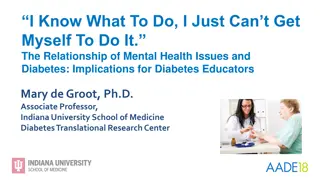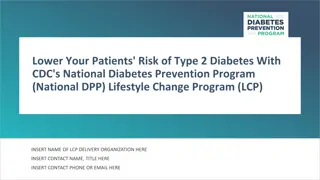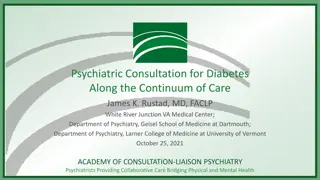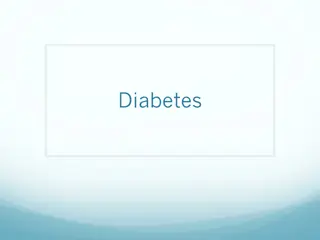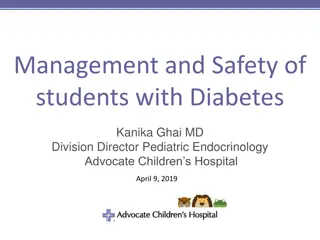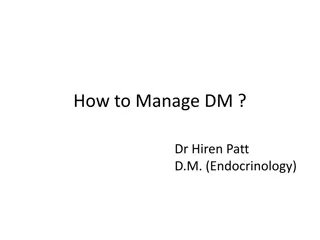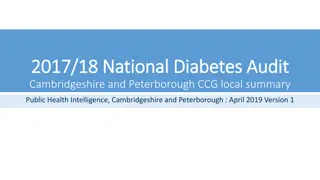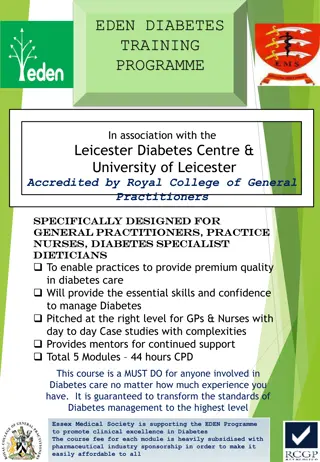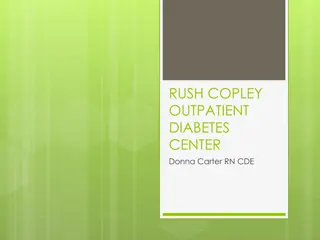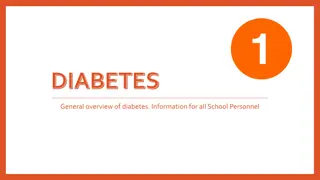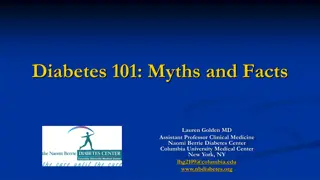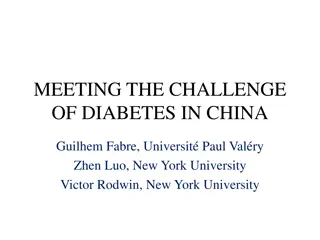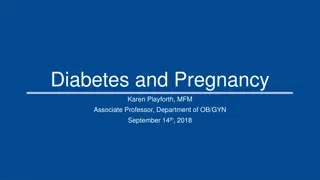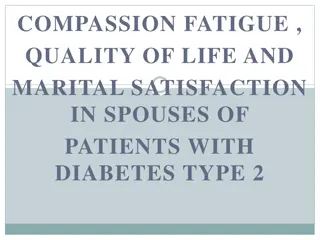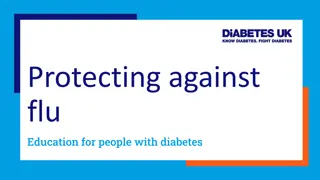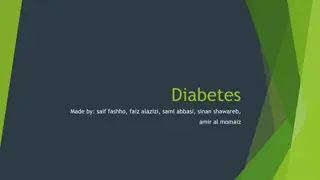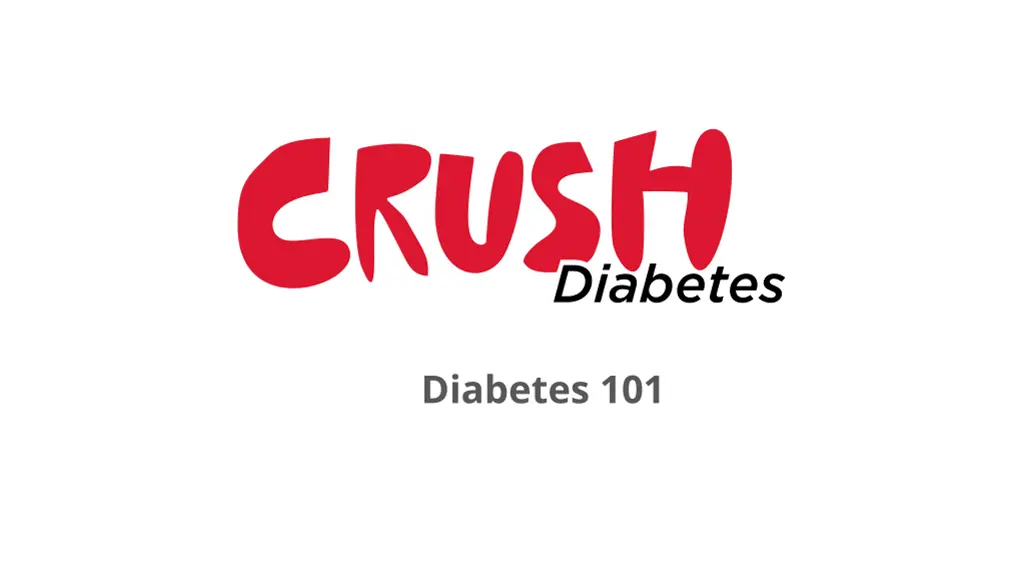
Understanding Diabetes: Causes, Symptoms, and Management
Explore the fundamentals of diabetes, including its types, causes, and symptoms. Learn how the body uses fuel for energy, insulin facts, and the differences between Type 1 and Type 2 diabetes. Discover the warning signs of Type 1 diabetes and how it affects individuals. Access informative resources and visuals to deepen your knowledge about this prevalent health condition.
Download Presentation

Please find below an Image/Link to download the presentation.
The content on the website is provided AS IS for your information and personal use only. It may not be sold, licensed, or shared on other websites without obtaining consent from the author. If you encounter any issues during the download, it is possible that the publisher has removed the file from their server.
You are allowed to download the files provided on this website for personal or commercial use, subject to the condition that they are used lawfully. All files are the property of their respective owners.
The content on the website is provided AS IS for your information and personal use only. It may not be sold, licensed, or shared on other websites without obtaining consent from the author.
E N D
Presentation Transcript
Learning Objectives Understand the: Etiology Pathophysiology Prevalence - - - of Type 1 and Type 2 diabetes.
Fact or Fiction? Type 1 diabetes is caused by eating too much sugar.
What is Diabetes? https://health.utah.edu/nutrition-integrative- physiology/community-outreach/utah-center- community-nutrition/clinical-nutrition-resources
How Does My Body Use Fuel for Energy? You consume food which is fuel for your body Your body digests the food and turns it into glucose Glucose gets into your bloodstream Your pancreas provides your body with insulin Insulin helps to get the glucose from your bloodstream into your cells Your cells are then able to use the glucose for energy
Insulin Facts Hormone made by your pancreas Life-saving and life sustaining Helps your body use glucose for energy Type 1 Diabetes: o Pancreas is unable to produce insulin https://health.utah.edu/nutrition-integrative- physiology/community-outreach/utah-center- community-nutrition/clinical-nutrition-resources Type 2 Diabetes: o Pancreas is not able to produce enough insulin o Body is resistant to using insulin
Type 1 Diabetes https://health.utah.edu/nutrition-integrative- physiology/community-outreach/utah-center- community-nutrition/clinical-nutrition-resources
Type 1 Diabetes About 5 -10% of people with diabetes have Type 1 Autoimmune disorder Body attacks itself and destroys cells in pancreas which produce insulin Pancreas is unable to produce insulin and cannot use glucose Must inject themselves with insulin through shots or insulin pump This is a blood glucose monitor used to measure blood sugar levels Warning Signs Warning signs and symptoms Usually occurs suddenly Excessive thirst Frequent urination Increased appetite Rapid weight loss Unexplained fatigue High amounts of sugar in blood/urine Sweet odor may be present in urine or breath or body sweat o
Type 2 Diabetes https://health.utah.edu/nutrition-integrative- physiology/community-outreach/utah-center- community-nutrition/clinical-nutrition-resources
Type 2 Diabetes About 90-95% of people with diabetes have Type 2 o Was primarily diagnosed in older adults o Increasingly common in children and teenagers Influenced heavily by lifestyle o Can make insulin but cannot make enough o Pancreas is not able to make enough insulin and/or the body doesn t use it properly Can be controlled through nutritious diet and regular physical activity
Type 2 Diabetes Warning Signs Warning Signs and Symptoms Can occur slowly over time Blurred vision Tingling or numbness in legs, feet or fingers Recurring skin, gum or urinary tract infections Drowsiness Slow healing of cuts and bruises Any symptoms that occur with Type 1 diabetes
Why are Type 2 Diabetes Numbers Rising? Teenagers and children are spending more time being inactive o Video games o Television o Computers Increased consumption of processed junk foods o Easy to access o Can be lower cost Added sugars o Soda o Candy o Cookies o Ice Cream
Consequences of Diabetes Having high and uncontrolled blood sugar can lead to many serious health issues o Blindness o Damage to circulation in hands and feet eventually leading to amputations o Kidney failure o Heart disease Eating a healthy diet and regular physical activity o Helps with blood sugar levels in both Type 1 and Type 2 o People with Type 1 still need to take insulin
Managing Blood Glucose People with both Type 1 and Type 2 diabetes have to monitor their blood glucose How do they do this? Give themselves finger sticks especially before & after meal times o For Type 1 Lets them know how much insulin they need o For Type 2 Lets them know what foods and activities affect their blood sugar Low Blood Sugar Dizziness, weakness or fainting High Blood Sugar Extreme thirst, blurry vision, weakness or dizziness
What is an A1C Test? Blood test Reported as a percentage Tests what your blood sugar has been over the last 2-3 months Is used to diagnose Type 1, Type 2 and pre-diabetes Levels o Under 5.7% Normal o 5.7%-6.4% Pre-diabetes o 6.5% and above Diabetes
Take Home Message Diabetes occurs when your blood sugar is higher than normal and affects how your body changes food into energy Type 1 diabetes Autoimmune disorder where the body attacks itself and destroys cells in pancreas which produce insulin Type 2 diabetes When the body either cannot make enough insulin or the body doesn t use it properly Diabetes numbers are on the rise because of - o Increased consumption of junk food o Added sugars o Inactivity Eating a healthy diet and regular physical activity helps with blood sugar levels in both Type 1 and Type 2 diabetes
Discussion Questions Why is Type 2 diabetes referred to as the lifestyle disease? What are the most common steps taken to try and control Type 2? How does Type 1 diabetes differ from Type 2? The number of cases of Type 2 diabetes is rising quickly in teenagers and even in children. What do you think is contributing to these increasing numbers in our culture? What role does insulin play when it comes to Type 1 diabetes? What is an A1C test? In-Class Activity Pancreas Appreciation Day Worksheet
References All the sources from the current Crush Diabetes curriculum. American Diabetes Association (n.d.). Understanding A1C. Retrieved from https://www.diabetes.org/a1c Diabetes State Burden Toolkit. (2020). Retrieved from https://nccd.cdc.gov/Toolkit/DiabetesBurden/YLL Kidshealth (2020). Type 1 Diabetes: What is it? Retrieved from https://kidshealth.org/en/kids/type1.html

